|

Carolus-Duran
2nd painting
John Singer Sargent
-- American painter
1879
Clark Art Institute,
Williamstown, Massachusetts
Oil on canvas
116.8 x 95.9
cm (46 x 37 3/4
in.)
Jpg:
Carol Gerten's Fine Art
Charles Auguste
Émile Duran (1837-1917) better known as Carolus-Duran was
Sargent's teacher and
would
have a profound impact on him.
When Sargent went to
Paris in May of 1874, it was with the goal of gaining entrance of the Ecole
des Beaux-Arts. To achieve this, however, the family knew he needed
to study
at one of the independent ateliers and in a matter of only ten days
they had
searched, interviewed, and then finally accepted by Carolus-Duran. In
truth,
it wouldn't be the Ecole, but Carolus-Duran who would have the most
impact on
the young artist.
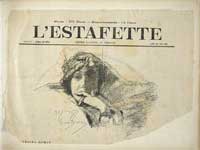
Page from "L'Estafette" with Reproduction
of Carolus-Duran Drawing
(Pasted in John Singer
Sargent's sketchbook)
June 28, 1880
* * *
Carolus-Duran was born at
Lille on July 4, 1837. He studied at the Lille academy with the
sculptor Augustin-Phidias
Cadet de Beaupré then at the age of 15 began an apprenticeship
in the
studio of François Soucho. In 1853 he moved to Paris and took
classes
at the Académie Suisse. Then in trips to Italy and Spain
from 1862-70
when he paid special attention to Velazquez -- the Spanish Master whom
he felt
was the most important of all the Masters. Returning once again to
Paris where
he opened his own studio in 1872.
With his success he made
a number of artistic acquaintances, including Fantin-Latour,
Courbet, Manet,
Monet, and Astruc all of whom he would
establish
life-long friendships.
He became best known as a
portrait painter and his status as head of his atelier. The
Assassination (1866)
was one of his first successes. His Lady
With the Glove (1869), a portrait of his wife was bought for
the Luxembourg
museum is another. In 1878 he finished a mural The
Triumph of Maria de Medici first intended for the Palace
Luxembourg in which Sargent
help.
Carolus-Duran reveled in
the attention of his status as one of the leading portrait artists and
teacher in the city. His flamboyance was almost unmatched. In an
article dated June of
1885 in "Art Age" gives you a glimpse:
Everybody familiar with
the artistic haunts of Paris knows Carolus Duran, with his bushy black
curls thickly streaked with gray, his costume always at the height of
the mode, his hat always a little in advance of it, his flowing
wristbands and gold bracelets soldered upon his wrists, and his general
air of a Fortuny cavalier toned down to walk the Boulevards. . . . [as
many] old Parisians ... were familiar with the sight of the young
Carolus drawing his blouse tightly about his figure and writhing to see
himself from all points of view in large restaurant mirrors as he
exclaimed, 'The torso of an Apollo !'
(Art Age, June
1885, quoted in Barbara Weinberg, Uncanny Spectacle : The Public Career
of the Young
John Singer Sargent)
In
1889 Carolus-Duran became one of the founders of the
Société Nationale des Beaux-Arts, then became
president in 1898. By
1904 Carolus-Duran
was awarded membership
to the Legion
d'Honneur. The following year was appointed director of the French
academy
at Rome: Socitété Nationale des Beaux-Arts.
L' Illustrat
29 Oct 1910
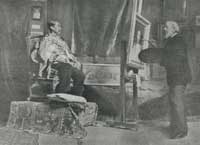
Carolus-Duran
painting King Chulalongkorm
1907
He died in Paris on
Feb. 17, 1917.
(Encyclopedia Britannica,
Vol. 7,
William Benton, 1962, p.748)
As for Sargent's portrait
of his dear teacher, John was eager to get it out in the public for
full
viewing:
The first place,
appropriately, would be to show it off in Paris at the annual Salon
where Carolus-Duran was best known. The painting would be a sure thing
-- if he didn't make any major mistakes -- and would assure a ton of
exposure for the young
artist
-- it worked:
Le Journal amusant
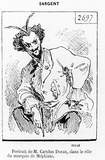
Le
Salon de 1879
Paris 1879
- Salon de 1879
(R., "The Last
Paris Salon. II," American Architect and Building News 6, no. 199, 18
October 1879)
If I kept for
the last Mr. John S. Sargent's portrait of his master, Carolus Duran,
it is that I may criticise him, not merely as an American, but as a
painter who has already fairly won a place in the foremost rank of
young French painters ... Without giving Mr. Sargent too much credit
for the admirably spirited pose - it is quite in Duran's temperament
himself to take the most becoming pose - one cannot fail to admire his
original and masterly scheme of color. It was a happy idea to paint his
sitter in a loose morning jacket, of soft pale yellow, against a cold
gray background, but only the highest artistic sensibility would have
thought to call out all the subtleties in this gray harmony, and set it
vibrating by a single gleam of turquoise blue from the arm of the
chair. The interest centres in the pale expressive head, - flattened
[flattered?], Duran's enemies say; a fair and generous expression of
the man when at his best and aglow with his noblest thoughts, cry his
friends; and a portrait is painted for a man and his friends, not for
his enemies. A quite unconscious idealization is a characteristic of
Mr. Sargent's talent. Even in his daily atelier studies he manages,
without sacrificing their value as studies, to throw over the coarse
vulgarity of the model a charm and elegance quite his own. It is a rare
gift, this atmosphere of sentiment, which is too distinguished ever to
be sentimental. But this would attract little attention from the
prosaic French art-world were it not seconded by as distinguished
technical qualities. Mr. Sargent, like a true colorist, models, rather
than draws, but there is no suggestion of feebleness in drawing, and
the only adverse criticism I have heard brought against this
much-noticed portrait was a thinness in the painting. This, however,
taking in view the rather sketchy scheme of the work, has little
weight, and is quite lost sight of in the charm of the wonderful
simplicity and freshness of the brush work, qualities which are at
present so much
the fashion here that many clever painters are sacrificing all else to
them.
* *
*
Outremer,
"American Painters at the Salon of 1879," Aldine 9, no. 12, 1879
John S.
Sargent received "honorable mention" for his portrait of Carolus Duran,
which
was really one of the best portraits of the Salon. Mr. Sargent has the
trick
of
making
the "human face divine" more so, infusing a soul into his model where
very little
exists.
1880
The following year
Sargent sent the
painting to New York
New York 1880 -
Society of American Artists Third Annual Exhibition
("Fine
Art. Society of American Artist," New York Daily Tribune, 25 March 1880)
We note also
the arrival of a picture by Mr. John S. Sargent, a portrait of the
artist Carolus Duran ... Nothing that the artist has sent home
heretofore will have introduced him so effectually to his countrymen as
this portrait, a work which must challenge admiration and from which
criticism cannot escape if it would.
* *
*
("One Day in the
Gallery. Society
of American Artists," New York Times ,26 March 1880)
The new
sensation since the opening of the exhibition is a most life-like and
speaking portrait of the French painter, Carolus Duran ... who is
cordially liked or cordially detested by each member of the art colony
of Paris. He is seen to be a typical Frenchman, even to the very curl
of his mustache, and evidently dead in earnest. No one could imagine
him humorous for a moment. Mr. Sargent has caught the very spirit of
the man, and reproduced him bodily, with
almost the same cleverness Duran himself shows.
* *
*
("Fine Arts. The
Society of
American Artists. - Modern American endency," Nation 30, no. 770;1
April
1880)
Mr. Sargent has
contributed the portrait of Carolus Duran from last year's Salon, with
a well-moulded colorless head, and hands treated on an entirely
different principle of modelling, so that we seem to see a sculptured
head with paper extremities ; his inconsistency here shocks the sight
in America, as it lost him a medal in France.
* *
*
("The American
Artists. Close
of the Exhibition," New York Times ,16 April 1880)
This portrait
may be termed celebrated, for not only did it enter the Salon and
create much talk among artists in Paris, but it has been reproduced in
the fine books of art that describe the Salon, and had the somewhat
doubtful honor of a piece of "chiseled" verse at the hands of one os
the minor French poets of today. It must be a pleasure to an artist to
examine the workmanship of this thoroughly workmanlike production.
There is a fine certainty and breadth to the strokes, an audacity in
pose, a vigor in expression of character, which would make it
remarkable anywhere. Mr. Sargent gives a somewhat effeminate effect to
his "dear master
Carolus" by showing the lace cuffs of his shirt, the broad stripe of
his trousers,
his jaunty cravat, and a colored handkerchief. To sober
Americans
this "master" may seem a little on the order of fops, but how
thoroughly the
pupil has learned his lesson ! How admirably he has placed color by
color, and
brought harmony out of shades of gray and brown put cleverly
side by side.
* *
*
(S. G. W.
Benjamin, "Society
of American Artists. Third Exhibition," American Art Review I, no. 6;
April
1880)
In every
particular Mr. Sargent's Duran is not only a grand rendering of a
striking subject, but also as good an example as we can probably get of
the present state of
portraiture
in France.
* * *
At the
Society's rooms, to cease from generalities, the two canvases that
attracted us first, were Mr. Chase's portrait of General Webb, and Mr.
John Sargent's of Carolus Duran. They were apt to be noted together,
not only for the excellence common to them both, but for their
divergence from one another ... [Sargent's] is French work through and
through. French no less in the technique, which is twin to that of more
than one Parisian we know of, than in its
feeling
and its meaning as a work of art.
M. G. van
Rensselaer, "Spring
Exhibitions and Picture-Sales in New York.-1," American Architect and
Building
News 7, no. 227 (1 May 1880)
After the Society of
American Artists the painting went on to Boston:
Boston
1880 - St.
Botolph Club Inaugural Exhibition
("Art
Notes," Boston Evening
Transcript, 21 May 1880)
The two famous
portraits by William M. Chase
and John S. Sargent (both young New York artist), facing each other in
the midst of the gallery, are almost enough in themselves for an
exhibition ... Both these portraits have the insouciance of pose that
so shocks the old-fashioned portrait-painter who has to obey the
directions of his sitter and the intelligent jury of relatives and
friends usually called in to sit on his work ... The young Parisian in
the elegant negligence of a morning dress, with frilled shirt cuffs,
gray lounging jacket and striped trousers, leans forward, his hands or
arms lightly resting upon his knees, but with an instinctive grace and
politeness even in this most unceremonious of postures ... Mr.
Sargent's portrait is painted much more simply, even slackly, one
thinks ... But it will be seen on carefully looking at Mr. Sargent's
work that the face and head have been wrought out with the finest
knowledge, feeling and care, supplemented with the finest skill, as was
befitting so rare a subject, and that the whole head is as "solid" as
it is dashing in
effect.
* *
*
(See Carolus-Duran
theory on painting: The
Century; 1886 “A French
Student
and His Pupils”)
(See Mary
Crawford Volk's take on Carolus-Duran)
Notes:
Exhibitions
John Singer
Sargent,
An Exhibition -- Whitney
Museum, NY & The Art Institute of Chicago 1986-1987
|
|

Works
by Carolus-Duran
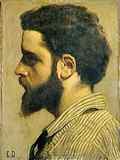
Zacharie
Astruc (1833-1907)
c.
1860 ?
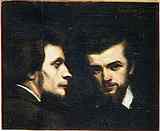
Fantin-Latour
and Oulevay
1861

Edmond
Lebel
1862
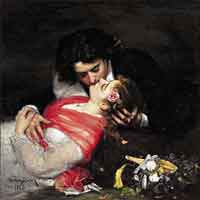
Le Baiser
(The Kiss)
1868
(the artist and wife as a newlyweds)
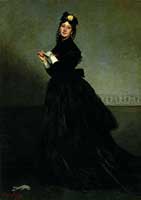
Lady with
a Glove
1869
(artist's
wife)

Merrymakers
1870
(Thumbnail
only)
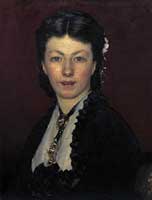
Madame
Neyt
1871

Countess
Ratazzi
(née
Maria-Laetitia Bonaparte-Wyse)
1872
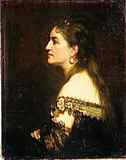
Portrait
of woman with décolletée
c.
1875

Portrait
of Nadezhda Polovtseva
1876
CGFA
Hermitage
Musuem
Oil
on canvas
206x124.5
cm
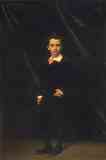
Portrait
of Philippe Durand
1876
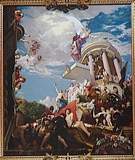
The
Triumph of Maria de Medici
1875-1878
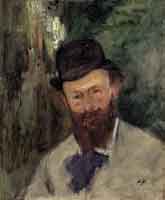
Portrait_d’Edouard_Manet
c. 1877
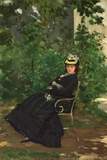
Portrait
of Madame Alice Hoschedé (afterwards, Madame Monet)
1878
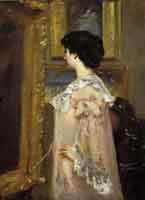
Artiste
dans son atelier (Artist in her workshop )
c. 1880
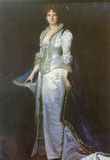
Queen
Maria Pia of Portugal
1880
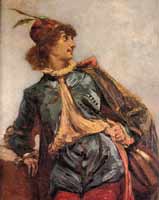
Count
Robert de Montesquiou the role of the traveler
1880s?
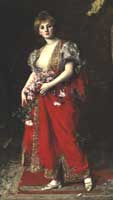
La
Fille de L’émir
1883
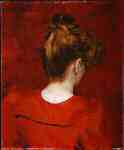
Study
of Lilia
1887
Natational
Gallery of Art, Washington DC
Oil
on canvas
.55 x 46
cm (21 5/8 x 18 1/8 in.)
New
Century Fund, Gift of Edwin L. Cox - Ed Cox Foundation 1999.45.1
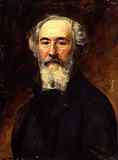
Emmanuel
Lansyer
1889

Louis Rene
Count of Gramont
c.
1890
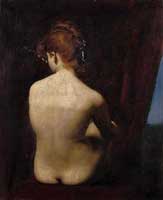
Lilia
1890

Mrs.
William Astor (Caroline Webster Schermerhorn, 1831–1908)
1890
Metropolitan
Museum of Art
Oil
on canvas
212.1
x 107.3 cm (83 1/2 x 42 1/4 in.)
Gift of R.
Thornton Wilson and Orme Wilson, 1949 (49.4)

Margaret
Anderson, Wife of the Honorable Ronald Grenville
1891
CGFA
Oil
on canvas
Polesden
Lacey, Surrey.
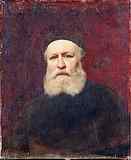
Charles
Goundod (1818-1893)
1898
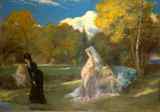
Après
la Nage
1899

Danae
c.
1900
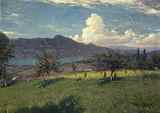
Les
Pommiers (Apple Trees)
1900
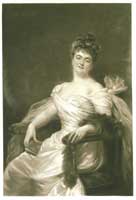
Mme. La Baronne de ***
1901
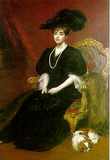
Anna
Gould
Date?
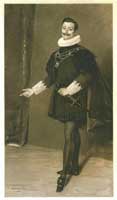
Don Fernando del F. . .
1908
|




